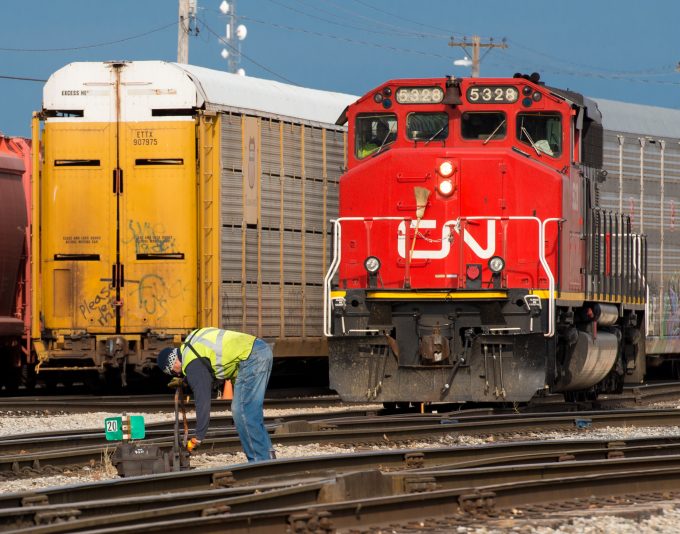Cargo chaos looms as strikes threaten Canada's ports and rail networks
Strike action has threatened to erupt at both Canada’s ports and rail networks, leaving the ...
TFII: SOLID AS USUALMAERSK: WEAKENINGF: FALLING OFF A CLIFFAAPL: 'BOTTLENECK IN MAINLAND CHINA'AAPL: CHINA TRENDSDHL: GROWTH CAPEXR: ANOTHER SOLID DELIVERYMFT: HERE COMES THE FALLDSV: LOOK AT SCHENKER PERFORMANCEUPS: A WAVE OF DOWNGRADES DSV: BARGAIN BINKNX: EARNINGS OUTODFL: RISING AND FALLING AND THEN RISING
TFII: SOLID AS USUALMAERSK: WEAKENINGF: FALLING OFF A CLIFFAAPL: 'BOTTLENECK IN MAINLAND CHINA'AAPL: CHINA TRENDSDHL: GROWTH CAPEXR: ANOTHER SOLID DELIVERYMFT: HERE COMES THE FALLDSV: LOOK AT SCHENKER PERFORMANCEUPS: A WAVE OF DOWNGRADES DSV: BARGAIN BINKNX: EARNINGS OUTODFL: RISING AND FALLING AND THEN RISING

Trains have again been limping out of the port of Vancouver to the Canadian interior, due to damaged tracks and increased safety measures.
Meanwhile, at the port, vessels are piling up, prompting warnings of lengthy delays.
The devastating wildfires that ravaged the Canadian town of Lytton and the nearby First Nations community this month continue to take a toll on freight traffic moving through the Fraser Canyon Valley to and from the port of Vancouver.
The fire damaged the tracks of both Canadian National (CN) and Canadian Pacific (CP), as well as a bridge owned by the former. CP has managed to resume services on its line, but the CN line remains closed.
Under a co-production arrangement, CN is now moving trains on the re-opened CP line, besides diverting some traffic to BNSF infrastructure. However, the joint use of the track through the valley effectively halves capacity for the two Canadian carriers. By one estimate, the pair used to move up to 60 trains a day through the region.
CN has also shifted some traffic to its line that connects Vancouver with Prince George, up the coast, according to a company spokesman.
“We expect to run one to two re-routed trains a day,” he added.
The route through the Fraser Canyon Valley stands to be more time-consuming after the federal transport minister set slower train speeds in areas deemed to be at extreme risk of fire. This reduces permitted speeds from 26-35 mph to 25 mph.
The speed reduction is part of a package of measures aiming to reduce fire risk. Rail carriers are also required to step up the monitoring of tracks for fire risk and to set up an “interim extreme weather risk, fire mitigation plan”. The rules further stipulate that only locomotives can pass through areas that have been inspected in the past 15 days, to make sure their exhaust passages are clear of combustible material.
All this is dampening hopes for rail velocity to pick up again, and clear congestion along the tracks that have brought repercussions to the port of Vancouver. When the fire that devastated Lytton and the nearby community blocked rail operations, an estimated 4,000 rail cars were marooned along the line.
The Ag Transportation Coalition, which represents wheat, soy and canola producers, claimed that more than 1,000 rail cars loaded with crops were stuck at the time.
Last week, container lines serving Vancouver warned customers to expect delays for shipments going into the Canadian interior. On Friday Maersk warned customers it could take up to a week for intermodal services out of the port to return to normal.
With rail capacity first blocked and now seriously restricted, boxes have been piling up at the port’s four container terminals, with a knock-on effect on vessel unloading. According to data from Vancouver Fraser Port Authority, import containers moving on CN remain on the docks for a week or more.
On its website, the port authority informs users that “anchorage demand continues to be high and nearing full capacity. Demand for large vessel anchorages presently exceeds supply. Anchorages are assigned in a manner that ensures fluidity across all ship types and maintains essential services”.
The port has been inundated with traffic. In May its container throughput was up 39% year on year, and with a heavy peak season on the cards, further disruption is the last thing that importers need.
Some operators and cargo owners are trying alternative routings. Some vessel traffic has been re-routed to Prince Rupert, which is served by a rail network operated by CN that has not had problems from fires so far. Intermodal shippers have taken their boxes off the rail in Calgary to cover the distance to Vancouver by truck.
Comment on this article